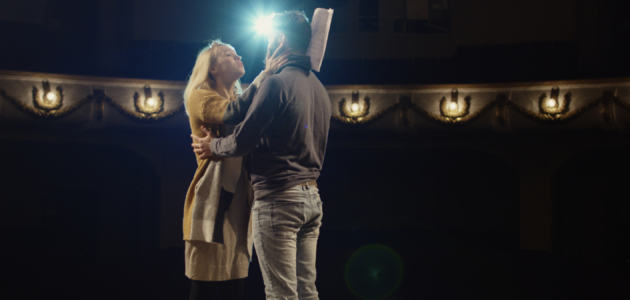

What just happened? Are these people two friends seeing each other for the first time since the summer break, or a condemned (but innocent) criminal greeting his smiling executioner? The joy of A/B scenes for actors is that both could be true. Without the context of a larger script or any supplementary information, A/B scenes (sometimes known as ‘open scenes’) give you all the power in the world to shape and bring them to life. They are extremely useful resources, which is why we at StageMilk decided to write and publish this collection.
This page contains a collection of free, original A/B scenes for actors, perfect for use in acting classes or drama workshops. These scenes contain minimal information regarding character and setting, allowing actors to experiment with characterisation and context using their given circumstances. In addition to traditional two-handers, there are scenes for multiple actors with the same, pared-back information.
Whether you are an actor looking to improve their craft or an acting teacher looking for resources in a drama class or workshop, this page will give you all the info you need to properly deploy and help your students/peers/yourself through the process. Scroll down to the bottom for additional resources StageMilk offers regarding free, original script available to our entire acting community.
Before you jump in, take a look at the following concepts to help you navigate the A/B scenes on offer. Just because information in the script is minimal, doesn’t mean you can skip any part of the script preparation process. If anything, it’s more important than ever to find the context and thrust of the scene.
Read the script, analyse the script and know the script. For A/B scenes, look at vocabulary and sentence structure in particular: what does one character’s style of speaking tell you about who they might be? Are sentences short or long? Does one character speak more than the other, or perhaps more confidently or emotionally than the other? Writers will always leave you hints in the words they chose (or didn’t.)
What does your character want in this scene from the scene? Lack of context or action does not mean that you can skimp on this. Even in the example at the top of this page (“Hi.” “Hi.”) an objective must be needed: perhaps Character A wants to intimidate Character B, whereas Character B wants their scene partner to remain calm.
Once you know what your character wants, it’s time to plot the actions/tactics they use to get them. Why does your character say a line? What’s the idea behind it that helps them achieve their goal?
Establish what’s happened to each character before the scene begins, and then play around with it. “Hi.” “Hi.” could have happened after a lousy speed-dating event. It could also have happened after A caught B cheating on them after twenty years of marriage.
These classic Stanislavski questions of who, where, when, what, why and how will help you ground you choices in A/B scenes. The more context you can build with the given circumstances, the more realistic and compelling your scenes will be.
Finally, be sure that you keep changing things around in these scenes: once you’ve played it a certain way, challenge yourself to re-invent the situation entirely. What else can you discover? What risks can you take?
While none of these scenes exceed a minute in length, it may be preferable in some instances to ‘split’ the text and only use a fragment for performance and analysis. This is particularly recommended for drama teachers—who may wish to use this material with greener students.
Genre: N/A
Length: 1 min
Synopsis: A surprises B after time apart.
Genre: N/A
Length: 1 min
Synopsis: A would like to return something with B’s help. For cash, preferably.
Genre: N/A
Length: 1 min
Synopsis: A would like to sit with B to cheer them up. B has other ideas.
Genre: N/A
Length: 1 min
Synopsis: A doesn’t want B to worry about something, but they won’t get specific.
Genre: N/A
Length: 1 min
Synopsis: A catches B up on a big development.
Genre: N/A
Length: 1 min
Synopsis: A wants B to do something. B knows they have to, but hesitates.
Genre: N/A
Length: 1 – 2 mins
Synopsis: A is going on a trip. B is nervous about it.
Genre: N/A
Length: 1 – 2 mins
Synopsis: A and B run into each other after a time apart.
Genre: N/A
Length: 1 min
Synopsis: A is searching for something. Be is not being helpful.
Genre: N/A
Length: 1 min
Synopsis: A wishes B to remember.
Genre: N/A
Length: 1 min
Synopsis: A and B talk before leaving the house.
Genre: N/A
Length: 1 min
Synopsis: A is embarrassed by something. B would like them to drop it.
Genre: N/A
Length: 1 min
Synopsis: A is sitting in B’s seat. How dare they.
Genre: N/A
Length: 1 min
Synopsis: A has big news for B, right before they make a life-changing confession.
Genre: N/A
Length: 1 min
Synopsis: B has an issue with the way A has procured something important.
These scripts follow a similar format to A/B scenes, but contain additional characters. These scenes may be useful in larger drama class settings, or for scene study workshops.
Genre: N/A
Length: 1 min
Synopsis: A is informed by B and C that they are out.
Genre: N/A
Length: 1 min
Synopsis: A, B and C have an awkward disagreement over an order.
Genre: N/A
Length: 1 min
Synopsis: A, B, C and D try to relax, but it’s not so simple. Apparently.
A/B scenes are invaluable resources for actors that help train an understanding of the theory of character and drama. However, due to their short nature, they may only take you so far in your exploration of text. So once you’re done working with these pieces, you might like to take a look at some of the original material we offer here at StageMilk.
Original content:
Resources for acting and script work:
All things showcase and presentation:
Across these pages (and the one you’re reading now), remember to check in regularly for new uploads. We are forever adding fresh original scripts for all your acting needs.

Alexander Lee-Rekers is a Sydney-based writer, director and educator. He graduated from NIDA in 2017 with a Masters in Writing for Performance, and his career across theatre and television has seen him tackling projects as diverse as musical theatre, Shakespeare and Disney. He is the co-founder of theatre company Ratcatch (The Van De Maar Papers, The Linden Solution) and co-director of Bondi Kids Drama, a boutique drama school offering classes to young people in the Eastern Suburbs. Alexander is drawn to themes of family, ambition, failure and legacy: how human nature can flit with ease between compassion and cruelty. He also likes Celtic fiddle, mac & cheese and cats.

Connect with us!



